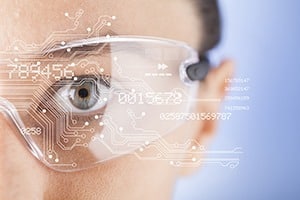What is pick-by-vision?
Definition of pick-by-vision: picking based on data glasses
The faster an order picker can act without forcing errors or damage, the more efficient their operation is. Pick-by-vision is a new picking method that allows the user to use both hands to handle the goods at all times. This is made possible by the use of data glasses, an example of which would be Google Glass. How does this work?
- Transfer of all central data to the user (in real time)
- Smart control using display tasks that do not require the active involvement of the order picker
- Transfer of the storage space incl. corresponding number of picks
- If required: barcode capture also possible
Advantages of pick-by-vision: direct detection of picking errors
Time is an important factor in warehouse logistics, as it determines whether upstream or downstream processes can be carried out without delay. At the same time, certain picking methods are associated with a certain susceptibility to errors, which must be taken into account. Pick-by-vision is a method that works regardless of location and uses visualization via data glasses (head-mounted display) to present all key aspects to the order picker.
An overview of the advantages of using pick-by-vision:
- Reduction of errors in order picking, in particular through the direct possibility of visual inspection
- Reduction of non-active times (dead time, base time, travel time), in particular by displaying information on the route and the next pick
- Intuitive control thanks to clear linking of all important individual steps
- Increased picking speed and higher quality at the same time
- Suitable for various types of storage
Don’t forget: Thanks to direct synchronization with the warehouse system, pick-by-vision is a coveted innovation in logistics. This makes the company more efficient and flexible, especially thanks to digital pick lists and the use of both hands.
Disadvantages of pick-by-vision: limited usability and high adaptability given
As is usual with any product innovation, the use of pick-by-vision also comes with certain disadvantages. This has to do above all with information processing, which is visual and therefore requires absolute concentration on the part of the user. We therefore do not want to ignore the risks of pick-by-vision:
- Higher workload due to an increased level of visual information processing
- Increased risk of accidents due to the user’s restricted field of vision
- Short battery life requires precise planning of pick-by-vision applications
- Risk due to visual distraction, which increases the risk of accidents
- Higher workload due to an increased number of cycles (significantly higher cognitive load)
Important: the relevant indicator for logistics companies is and remains the error rate in order picking. Pick-by-vision appears to be suitable for significantly reducing this – however, several studies indicate that an adaptation of the work environment and work organization is necessary due to higher cognitive strain.
Important points when dealing with pick-by-vision
For reasons of flexibility alone, it makes sense to make the use of an order picker as dynamic as possible. This increases quality and speed, as real-time data exchange means that priority can always be given. Pick-by-vision makes it easy to optimize the tour so that the most efficient route is always taken by displaying the order, shelf or pallet. This is possible with the combined use of tracking systems that continuously record the employee’s location and feed it into the system.
In the future, the further development of pick-by-vision will focus primarily on further reducing the already low error rate. Although digitalized processes as such represent a high level of security, there are naturally sources of error that are fueled by the human factor. Pick-by-vision could be optimized, for example, by printing a barcode in the field of vision that also functions as a scanner. This makes it immediately clear whether the correct goods have been picked and collected. Depending on the system, a parallel visual display of the picking item is also possible.
In the proLogistik logistics lexicon you will find detailed descriptions of other picking methods, take a look!
